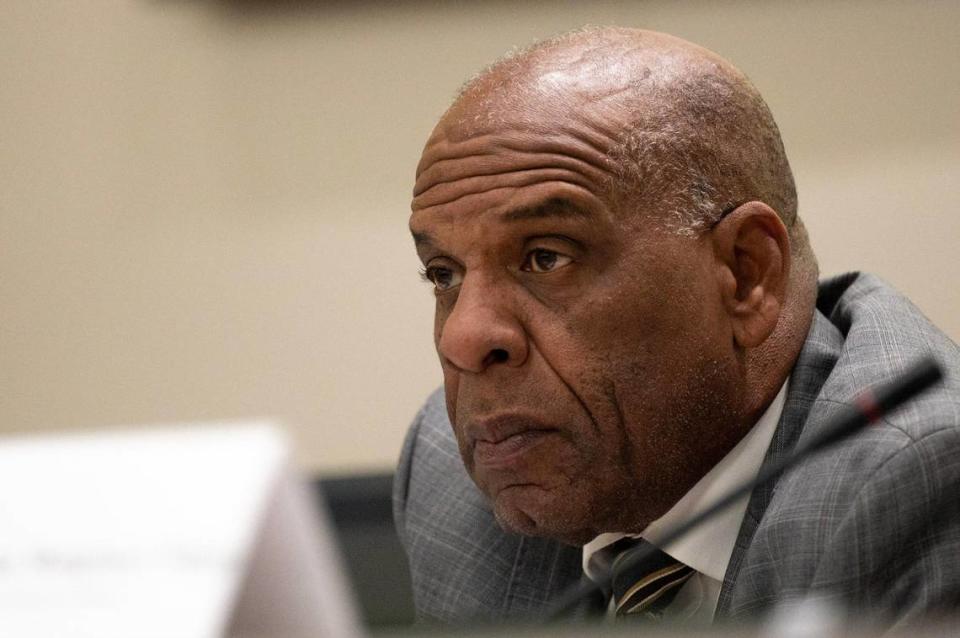California reparations package aims to heal history through Black homeownership
Help for Black first-time homebuyers, homeowners’ mortgage assistance and property tax relief for neighborhoods walled off by historic redlining are among the slate of reparations bills introduced to undo the legacy of racial inequity in California.
“Many Californians were denied the ability to prosper and build generational wealth as a result of racial bias,” said state Sen. Steven Bradford, D-Gardena, the housing bills’ author and vice chair of the California Legislative Black Caucus. “We must remove the stain.”
Fourteen bills make up the 2024 Reparations Priority Bill Package presented by Black lawmakers at the state Capitol are the fruits of work by the California Reparations Task Force. Its final report, at 1,100 pages and 115 recommendations, is a roadmap toward “repairing the harms of slavery — the progress we’re trying to make to address those harms,” Bradford said.
None of the bills address direct payments as a form of reparations.
“Reparations was never about payments. It’s about land,” he said later. “That’s how generational wealth is passed on — land.”
This has led California on a path to close the yawning gap in Black homeownership in the state and set more of the state’s Black households on a path toward building and accumulating wealth.
Roughly four in 10 Black families own homes in California, according to the California Housing Finance Agency — a number all but unchanged since the 1960s and before the federal Fair Housing Act in 1968 outlawed discrimination in housing.
The ratio lags far behind the state’s white, Asian-American and Latino homeowners, the state housing agency detailed in a 2021 report addressing the Black homeownership gap. Home equity makes up the majority of wealth for middle- and low-income families, making the disparity even more pronounced.
Homeowner divide spanning generations
“My grandmother never owned a home,” said Ashley Garner, whose grandmother died recently at 72.
The Bay Area real estate professional, activist and Sacramento native works extensively in both regions educating Black first-time homebuyers on homeownership. She also led the California Housing Finance Agency’s Build Black Wealth initiative to close the ownership gap.
“Our ancestors have come too far for us to be in the same place,” Garner said.
Garner, like Bradford, envisions a reparations program akin to the GI Bill, the post-World War II program that provided service members returning from war with free and low-cost education and low-interest home loans. The program helped build the foundation of the modern American middle class, but amid the racism and discrimination of the era in lending, housing and education, Black Americans were largely shut out from the gains.
“The GI Bill — that created wealth. That created opportunity. That same home that once sold for $6,000, is now worth $400,000,” Garner said. “If you want to make a difference and want to make it right, that’s education and that’s ownership. The value of what I’m going to give you is something tangible that’s going to start building a legacy. It starts with a foundation.”
But rising home prices in the Sacramento region combined with rising rental costs are pushing housing affordability further away. Nearly seven in 10 Black residents in the area say they struggle to afford mortgages or rent, according to Valley Vision, the Sacramento think tank focused on regional issues, in its annual Livability Poll in October.
“We’re still in the time period in Sacramento where there’s the possibility (of buying a home), but that time is fleeting,” said Rachael Taylor of Sacramento-based Tycoon Capital and the nonprofit Smart Housing Collaboration.
Taylor has worked in housing and capital for 25 years with a focus on Black communities in Sacramento and the Bay Area. She sees San Francisco’s notoriously steep housing and rental costs, barriers to lending and capital, and their contribution to its steadily vanishing Black population as a cautionary tale for Sacramento.
“(Sacramento) prices will start to reflect San Francisco’s; renters won’t be able to stay here. When we go in to apply (for loans), we’re not given the same ability to buy,” Taylor said. “And, the price of rentals takes up the majority of one’s income. You’re forever enslaved.”
Taylor’s right. Black renters are more likely to spend 30% or more of their household income on rent, according to the Public Policy Institute of California, shrinking the ability to save for a house.
Taylor says down payment and mortgage assistance “will make a tremendous difference,” but added that for reparations legislation to take root, local governments and housing agencies, lenders, nonprofits and builders also must be on board.
“We have been left so far behind. Reparations will help, but it starts with collaboration with the powers-that-be,” she said.
Funding to get these and other reparations legislation off the ground is butting up against a multi-billion dollar state budget deficit. Bradford does not yet have a dollar figure for the housing slate but said he will advocate for the state to set aside a portion of budget investments to “address these policies now and in the future.”
“Now, it’s time for action,” Bradford told reporters. “Without a doubt, the budget will impact what we do, but it is a reflection of our priorities and a reflection of our values. If we say we value reparations and are wanting to heal the harms of slavery in this country and in this state, we have to make this a priority. This is 160 years in the making. It’s not going to happen in one budget cycle.”

